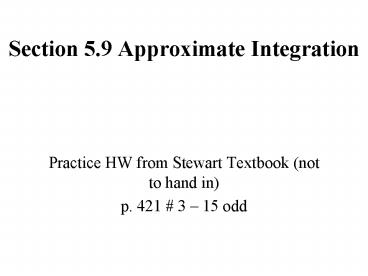Section 5.9 Approximate Integration PowerPoint PPT Presentation
1 / 23
Title: Section 5.9 Approximate Integration
1
Section 5.9 Approximate Integration
- Practice HW from Stewart Textbook (not to hand
in) - p. 421 3 15 odd
2
- Note Many functions cannot be integrated using
- the basic integration formulas or with any
technique of - integration (substitution, parts, etc.).
- Examples , .
3
- As a result, we cannot use the Fundamental
Theorem - of Calculus to determine the area under the
curve. We - must use numerical techniques. We have already
seen - how to do this using left, right, midpoint sums.
In this - section, we will examine two other techniques,
which - in general will produce more accuracy with less
work, - to approximate definite integrals.
4
Trapezoid Rule
- The idea behind the trapezoid rule is to
approximate - the area under a curve using the area of
trapezoids. - Suppose we have the following diagram of a
- trapezoid.
5
- Recall that the area of the trapezoid is given by
the - following formula
- Area of trapezoid (base)(Average of the height)
6
- Suppose we have a function which is
- continuous and bounded for .
Suppose we - desire to find the area A under the graph of f
from - x a to x b. To do this, we divide the
interval for - into n equal subintervals of
width - and form n trapezoids (subintervals) under the
graph - of f . Let
be - the endpoints of each of the subintervals.
7
8
9
- Summing up the area of the n trapezoids, we see
10
Trapezoid Rule
- The definite integral of a continuous function f
on the - interval a, b can be approximated using n
- subintervals as follows
- where , and
.
11
- Example 1 Use the trapezoid rule to approximate
- for n 4 subintervals.
- Solution
12
(No Transcript)
13
(No Transcript)
14
Simpsons Rule
- Uses a sequence of quadratic functions
- (parabolas) to approximate the definite integral.
- Theorem Given a quadratic function
- then
-
-
15
- We again partition the interval a, b into n
equal - subintervals of length . Note
that n must be - even. Here, we have
-
, n is even.
16
17
- On each double subinterval , we
- approximate the area under f by approximating
the - area under the polynomial p(x).
18
- Similarly,
-
, etc. - Repeating this process for all subintervals, we
get the - following rule.
19
Simpsons Rule
- Let f be continuous on a, b. For an even
- number of subintervals,
- where , and
.
20
- Example 2 Use Simpsons rule to approximate
- for n 4 subintervals.
- Solution
21
(No Transcript)
22
(No Transcript)
23
- Example 3 Use the trapezoidal and Simpsons
- rule to approximate using n 8
subintervals. - Solution (In typewritten notes)

